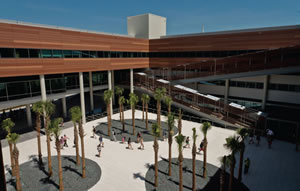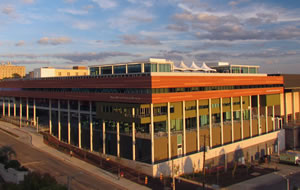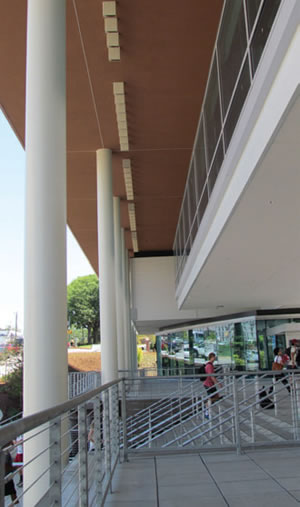TCO: In It For the Long Run

PHOTOS COURTESY OF THE UNIVERSITY OF SOUTH CAROLINA
“We have perfect
opportunity to move into a new
facility and practice new habits.”
That’s how Debbie Brumbaugh,
chief financial officer for the University
of South Carolina’s Darla Moore
School of Business, describes the
impact of the school’s new building,
just opened for the fall 2014 semester,
on the Columbia campus.
Since its founding in 1919 as
the School of Commerce, the Darla
Moore School of Business has grown
into a thriving site of academic
excellence, with an enrollment of
approximately 4,000 undergraduate
students and 800 graduate students.
The school’s faculty comprises 160
teachers, scholars and practitioners
whose expertise encompasses the
full spectrum of business disciplines
and who were themselves
educated at many of the finest
universities in the world.
The school’s new home is a
$106.5-million structure comprising
more than 250,000 square feet
on five levels. The building targets
LEED Platinum with an array of
technical and architectural features,
including its HVAC systems, green
roofs, solar volatics and daylighting,
among others. Net zero is a goal.
A SUSTAINABLE FOCUS
The building is a sign of both progress and intent at the university: There are now
16 green buildings on the Columbia campus, including nine LEED-certified ones;
another four certifications pending; as well as seven more buildings in design or
construction that will be LEED-certified Silver or higher, according the university’s
director of Sustainability, Michael Koman, one of the key people who have helped
shepherd green efforts on campus. The buildings will comprise 2.5 million square feet
of environmentally sustainable space by 2016, generating utility savings projected to
be at least $3.2 million annually, Koman says.
The Business School’s new building is a conspicuous marker of efforts across
campus — indeed by institutions nationally — to invest, build, maintain and operate
sustainably and with accelerating sophistication on many fronts.
Green got the green light at the University of South Carolina in the 1990s, when
officials established the university’s Environmental Advisory Committee and policies,
and now environmental sustainability is woven across the campus, integrated into
its culture in various ways. According to the university, “sustainability is a theme
throughout academic departments, both in the curriculum and research.” The initiative
has been recognized and ranked — Princeton Review’s 2013 Green Honor Roll and
a STARS Gold rating, for example — and the tactics include programs that support
efforts “in broadening and deepening courses related to sustainability,” an inventory
that keeps tabs on related coursework across curricula, and a green residence hall that
is essentially an immersion experience for students.
COMMUNITY INVOLVEMENT AND RESOURCES
Planning sessions and related events in recent years indicate an active cultivation
of expertise in the business community, and the university is also involved in
the Alliance for Sustainable Built Environments, through which Eaton Corp., KONE
Elevators, Kohler Co. and Johnson Controls have shared a broad range of insights to
green efforts on campus, Koman says.
The Business School has leveraged the expertise and perspectives of its own leadership,
faculty, staff and students toward green. A related strategic vision has been established
— it is characterized as “a viable extension” of the school’s focus on business
issues globally — and is implemented in many ways in education, research and in the daily life of the school, as well as in the
construction of the school’s new building.

PHOTOS COURTESY OF THE UNIVERSITY OF SOUTH CAROLINA
A key marker, as Koman points out,
was a $2-million U.S. Department of Energy
grant several years ago that is funding
research on building performance at
the new Moore School through energy
modeling, measurement and verification.
The impetus for the agency: It gets “a case
study with ongoing data production” on
precisely how the new building is using,
and saving, energy, and what lessons
could be learned for future projects.
Another marker for the Business School:
securing a $489,000 “Energy Wise” rebate
from the SCE&G utility company, which
worked with planners and looked at how the
new building’s design uses various energysaving
systems and methods. To take just
one of many, there is a metering plan to
“collect data on building performance and
occupant performance” in part to compare
these factors to spaces in the old building.
STUDENT PARTICIPATION
Students are playing a key role in green
programs across campus, and the effort to
marshal such participation at the Business
School is getting a running start: The school
has an active chapter of Net Impact — active
enough for students to fan out and take
note of offices where lights had been left on,
Brumbaugh remembers, as well as other
activities, such as shredding and recycling
competitions. She also describes a program
in which student teams will help train
building users as part of an overall building
systems training program budgeted
at $150,000 for the first year, an amount
projected to generate a greater return-oninvestment
over the life of the building, according
to Brumbaugh. Thus, it’s more than
just a building’s energy efficient systems;
it’s also about efficient behaviors.
In fact, as Koman sees it, the new
building’s opening was one point in what is
essentially a “continuous commissioning
process” to save money on maintenance
and building performance that could be a
model for others on campus.
THE BIGGER PICTURE
The new Moore School building can
be seen in a broader sense as a synergistic
initiative designed to help cement and
propel further a culture of sustainability
on departmental and campus levels. The
project is also designed to achieve savings,
attract key allies and funding and conduct
relevant research, all while “creating a better environment for our faculty, staff and
students,” Brumbaugh says.

PHOTOS COURTESY OF THE UNIVERSITY OF SOUTH CAROLINA
It can be a long process to make a
comprehensive green impact on a campus,
and to keep such efforts growing, developing
and increasing in their sophistication.
Koman offers encouragement to others
engaged in similar efforts on theirs, even
when some tactics and programs don’t
reach critical mass: “You can’t be everything
to everyone,” he says.
Looking back, Koman compares the
process of forging relationships to help implement
sustainability to juggling Velcro balls.
“Sooner or later,” he adds, “some will stick.”
THE TAKEAWAYS
Some takeaways about how to amplify
green efforts on campus:
- Remember that sustainability is in the
specifics. Invest the time and effort needed
with very vendor, contractor and subcontractor
on the specs and policies needed to
meet your green goals, says Brumbaugh.
- Start small when building a network of
sustainability stakeholders on and off
campus: For example, propose an initial,
joint effort on a limited, but needed, task
or project. Grow the relationship from
there, suggests Koman.
- Find green champions, Koman says — for
each initiative, who has a vested interest?
Leverage faculty and students’ interests
and trends in new green efforts.
- Institutionalize. In other words, ingrain
successful initiatives into your institution,
so those efforts are more likely to
continue. It’s about the institution, not
individuals, says Koman.
- Bear in mind that reaching out to potential
allies, including funders, is more
about sharing knowledge and expertise
than it is about money, Koman notes.
- Think through what your organization
has to offer in return for funding and/or
expertise. It could be research assistance
or networking opportunities.
- Trumpet your successes — before,
during and after each forward step,
such as partnering with a department
or holding an event or announcing a
project by an outside entity. Get word
out through LISTSERVs, emails, social
media, campus outlets and local print
and broadcast media.
- Find new allies, insights and expertise by
getting involved in your local chapter of
the United States Green Building Council
(usgbc.org/organizations/chapter) and
Net Impact (netimpact.org).
Net Impact (www.netimpact.org) is a
nonprofit membership organization for
students and professionals interested in
using business skills in support of various
social and environmental causes. It
serves both a professional organization
and one of the largest student organizations
in the world among MBAs. From its
central office in San Francisco, the organization
supports over 200 autonomous
volunteer-run chapters and a membership
base of over 10,000, with programs
and networking events focusing on
topics such as corporate social responsibility,
social entrepreneurship, nonprofit
management, international development
and environmental sustainability.
This article originally appeared in the issue of .